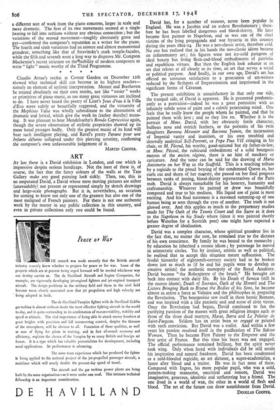ART
AT last there is a David exhibition in London, and one which is impressive despite serious handicaps. Not the least of these is, of course, the fact that the fancy colours of the walls at the Tate Gallery make any good painting look- sickly. Then, too, this is an amputated David, a David whose most moving pictures are either (unavoidably) not present or represented simply by sketch drawings and large-scale photographs. But it is, nevertheless, an occasion for coming to know not only one of the greatest but also one of the most maligned of French painters. For there is not one authentic work by the master in any public collection in this country, and even in private collections only two could be found.
David has, for a number of reasons, never been popular in England. He was a Jacobin and an ardent Revolutionary; there- fore he has been labelled dangerous and blood-thirsty. He later became first painter to Napoleon, and so was one ofthe chief victims of the lying propaganda and war hysteria in this country during the years 1802-14 He was a neo-classic artist, therefore cold. No one has realised that in his hands the neo-classic idiom became an inflammatory art ; his figures were not ice-cold paragons of ideal beauty but living flesh-and-blood embodiments of patriotic and republican virtues. But 'then the English look askance at an art that relates at all closely to its time, an art that serves a social or political purpose. And finally, in our own age, David's art has offered no sensuous satisfaction to a generation of art-writers seduced by the fleshpots of Impressionism and imprisoned in the significant forms of Cezanne.
The present exhibition is unsatisfactory in that only one side, the tranquil side, of David is apparent. He is presented predomin- antly as a portraitist—indeed he was a great portraitist with an infinitely subtle sense of paint and a calmly penetrating mind. One feels that he really knew the people whom he painted, and that he painted them with love ; and so they live on. Whether it is the portrait of Mme. David, With her obviously futile character, bulbous nose and ostrich feathers, or the portraits of his twin daughters Baronne Meunier and Baronne jeanin, the incarnation of Imperial vanity and inanition' or his own troubled and shrewdly analytical Self-Portrait, or Pope Pius VII cringing in his chair, or M. Pecoul, his worthy, good-natured but sly father-in-law,
or thme. Picoul, the rubicund embodiment of a solid bourgeois matron of the ancien, regime, there is no hint of mockery or caricature. And the same can be said for the drawing of Marie Antoinette on her Way to the Scaffold. This is a touching tribute by a regicide to the proud bearing of the' condemned Queen as, her curls cut and shorn of her majesty, she passed on her final progress between ranks of jeering, blood-thirsty representatives of the Paris mob. David is always remarkable for his honesty, humanity and craftsmanship. Whatever he painted or drew was beautifully composed and true to his medium. His liquid use of paint is most exciting. And his final statement is a reasoned summing-up of one human being as seen through the eyes of another. The truth is not glossed over. And this applies as much to the preparatory studies made for The Oath of the Tennis Court and the Sacre as it does to the Napoleon in his Study where (since it was painted shortly before Waterloo for a Scottish peer) one might have expected a greater degree of idealisation.
David was a complex character, whose spiritual grandeur lies in the fact that, no matter the cost, he remained true to the dictates of his own conscience. By family he was bound to the monarchy ; by education he inherited a rococo idiom ; by patronage he moved in aristocratic circles. Yet by instinct, artistic as well as political, he realised that to accept this situation meant suffocation. The feudal hierarchy of eighteenth-century society had to be broken down just as much as (if he and his pupils were to develop as creative artists) the aesthetic monopoly of the Royal Academy. David became "the Robespierre of the brush." He brought art back into contact with daily life. By his Death of Seneca (still in the rococo idiom), Death of Socrates, Oath of the Horatii and The Lictors Bringing Back to Brutus the Bodies of his Sons, he became almost as active a force as Voltaire and the phi/osophes in preparing the Revolution. The bourgeoisie saw itself in these heroic Romans, and was inspired with a like patriotic zeal and sense of civic virtue. Once the Revolution had begun, David continued to fan the purifying passions of the masses with great religious images such as those of the three dead martyrs, Marat, Barra and Le Peletier de Saint-Fargeau. Seldom has an artist been so engage or painted with such conviction. But David was a realist. And within a few years his passion resolved itself in the pacification of The Sabine Women. Then he became First Painter to the Emperor and the first artist of France. But this time his heart was not engaged. The official performance remained brilliant, but the spirit never took wing. Only when faced with individuals did he still retain his inspiration and natural frankness. David has been condemned as a cold-blooded regicide, an art dictator, a super-academician, a luster after blood and a traitor. He was in fact none of these. Compared with Ingres, his more popular pupil, who was a cold, pattern-making mannerist, uncritical and remote, David was imaginative, generous, idealistic and unflattering but a friend. The one lived in a world of wax, the other in a world of flesh and blood. The art of the future can draw nourishment from David.
DouGus COOPER,


































 Previous page
Previous page